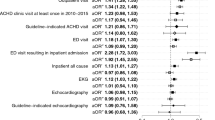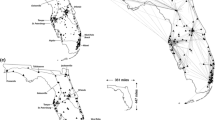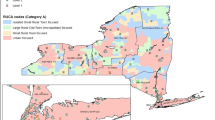Abstract
Travel distance to surgical centers may be increased when coverage restrictions prevent children with congenital heart disease (CHD) from receiving care at out-of-state congenital heart surgery centers. We estimated the minimum travel distance to congenital heart surgery centers among publicly insured infants with time-sensitive CHD surgical needs, under two different scenarios: if they were and were not restricted to in-state centers. Using 2012 Medicaid Analytic eXtract data from 40 states, we identified 4598 infants with CHD that require surgery in the first year of life. We calculated the minimum travel distance between patients’ homes and the nearest cardiac surgery center, assuming patients were and were not restricted to in-state centers. We used linear regression to identify demographic predictors of distance under both scenarios. When patients were not restricted to in-state centers, mean minimum travel distance was 43.7 miles, compared to 54.1 miles when they were restricted. For 5.9% of patients, the difference in travel distance under the two scenarios exceeded 50 miles. In six states, the difference in mean minimum travel distance exceeded 20 miles. Under both scenarios, distance was positively predicted by rural status, residence in middle-income zip codes, and white/non-Hispanic or American Indian/Alaskan Native race/ethnicity. For some publicly insured infants with severe CHD, facilitating the receipt of out-of-state care could mitigate access barriers. Existing efforts to regionalize care at fewer centers should be designed to avoid exacerbating access barriers among publicly insured CHD patients.

Similar content being viewed by others
References
Hoffman JI, Kaplan S (2002) The incidence of congenital heart disease. J Am Coll Cardiol 39:1890–1900
Connor JA, Gauvreau K, Jenkins KJ (2005) Factors associated with increased resource utilization for congenital heart disease. Pediatrics 116:689–695
Finlayson SR, Birkmeyer JD, Tosteson AN, Nease RF Jr (1999) Patient preferences for location of care: implications for regionalization. Med Care 37:204–209
Smith PC, Powell KR (2002) Can regionalization decrease the number of deaths for children who undergo cardiac surgery? A theoretical analysis. Pediatrics 110:849–850
Quintessenza JA, Jacobs JP, Morrell VO (2003) Issues in regionalization of pediatric cardiovascular care. Prog Pediatr Cardiol 18:49–53
Lorch SA, Silber JH, Even-Shoshan O, Millman A (2009) Use of prolonged travel to improve pediatric risk-adjustment models. Health Serv Res 44:519–541
Burki S, Fraser CD (2016) Larger centers may produce better outcomes: is regionalization in congenital heart surgery a superior model? Semin Thorac Cardiovasc Surg Pediatr Card Surg Annu 19:10–13
Danton MH (2016) Larger centers produce better outcomes in pediatric cardiac surgery: regionalization is a superior model—the con prospective. Semin Thorac Cardiovasc Surg Pediatr Card Surg Annu 19:14–24
Anderson BR, Fieldston ES, Newburger JW, Bacha EA, Glied SA (2018) Disparities in outcomes and resource use after hospitalization for cardiac surgery by neighborhood income. Pediatrics 141:e20172432
Erickson LC, Wise PH, Cook EF, Beiser A, Newburger JW (2000) The impact of managed care insurance on use of lower-mortality hospitals by children undergoing cardiac surgery in California. Pediatrics 105:1271–1278
Chang R-K, Chen AY, Klitzner TS (2000) Factors associated with age at operation for children with congenital heart disease. Pediatrics 105:1073–1108
Kucik JE, Nembhard WN, Donohue P, Devine O, Wang Y, Minkovitz CS, Burke T (2014) Community socioeconomic disadvantage and the survival of infants with congenital heart defects. Am J Public Health 104(11):150–157
Werner H, Latal B, Valsangiacomo Buechel E, Beck I, Landolt MA (2014) The impact of an infant’s severe congenital heart disease on the family: a prospective cohort study. Congenit Heart Dis 9(3):203–210
Fixler DE, Nembhard WN, Xu P, Ethen MK, Canfield MA (2012) Effect of acculturation and distance from cardiac center on congenital heart disease mortality. Pediatrics 129(6):1118–1124
United States Code of Federal Regulations. Title 42 (Public Health), section 431.52
United States Social Security Act, Section 1932 (b)(2)
United States Congress Bill. Accelerating Kids’ Access to Care Act. H.R.6524. Published 25 July 2018. https://www.congress.gov/bill/115th-congress/house-bill/6524. Accessed 12 Dec 2018
Committee on Child Health Financing, American Academy of Pediatrics (2013) Policy statement: Medicaid policy statement. Pediatrics 131(5):1697–1706
Schneider A (2018) How to make proper payments to out-of-state providers for Medicaid children with special health care needs. Georgetown University Health Policy Institute. Published 3 May 2018. https://ccf.georgetown.edu/2018/05/03/how-to-make-proper-payments-to-out-of-state-providers-for-medicaid-children-with-special-health-care-needs. Accessed 12 Dec 2018
FamiliesUSA. Fact sheet: interstate Medicaid billing problems and helping Medicaid beneficiaries who get care out of state. Published 18 April 2014. https://familiesusa.org/sites/default/files/product_documents/Interstate%20Medicaid%20Billing%20Problems.pdf. Accessed 12 Dec 2018
Welke KF, Pasquali SK, Lin P, Backer CL, Overman DM, Romano JC, Jacobs JP, Karamlou T (2019) Hospital distribution and patient travel patterns for congenital cardiac surgery in the United States. Ann Thorac Surg 107(2):574–581
Bhatt DR, Jue K, Stillwell J (2012) Congenital cardiac care providers in North America that offer open heart surgery for children. Congenit Cardiol Today (Partnersh Adult Congenit Pediatr Cardiol Sect Am Coll Cardiol). https://www.congenitalcardiologytoday.com/index_files/CCT-DIR-2012.pdf. Accessed 12 Jan 2017
Markus AR, Andres E, West KD, Garro N, Pellegrini C (2013) Medicaid covered births, 2008 through 2010, in the context of the implementation of health reform. Womens Health Issues 23:e273–e280
Medicaid analytic eXtract (MAX) general information. Centers for Medicare and Medicaid Services. Last modified 2 March 2018. https://www.cms.gov/research-statistics-data-and-systems/computer-data-and-systems/medicaiddatasourcesgeninfo/maxgeneralinformation.html. Accessed 7 Feb 2018
Harrington M, Kenney GM, Smith K, Clemans-Cope L, Trenholm C, Hill I, Orzol S, McMorrow S, Hoag S, Haley J, Zickafoose J, Waidmann T, Dye C, Benatar S, Qian C, Buettgens M, Fisher T, Lynch V, Hula L, Anderson N, Finegold K (2014) CHIPRA mandated evaluation of the Children’s Health Insurance Program: final findings. Mathematica Policy Research, Ann Arbor
Huybrechts KF, Palmsten K, Avorn J, Cohen LS, Holmes LB, Franklin JM, Mogun H, Levin R, Kowal M, Setoguchi S, Hernandez-Diaz S (2014) Antidepressant use in pregnancy and the risk of cardiac defects. N Engl J Med 370(25):2397–2407
Henry J. Medicaid State Fact Sheets. Kaiser Family Foundation. August 2013. https://kaiserfamilyfoundation.files.wordpress.com/2013/08/8050-06-medicaid-enrollment.pdf. Accessed 7 Feb 2019
Bazzoli GJ, Lee W, Hsieh HM, Mobley LR (2012) The effects of safety net hospital closures and conversions on patient travel distance to hospital services. Health Serv Res 47(1.1):129–150
Bliss RL, Katz JN, Wright EA, Losina E (2012) Estimating proximity to care: are straight line and zipcode centroid distances acceptable proxy measures? Med Care 50(1):99
Gregory PM, Malka ES, Kostis JB, Wilson AC, Arora JK, Rhoads GG (2000) Impact of geographic proximity to cardiac revascularization services on service utilization. Med Care 38(1):45–57
SOI tax stats—individual income tax 2012 zip code data. United States Internal Revenue Service. Last updated 18 May 2018. https://www.irs.gov/statistics/soi-tax-stats-individual-income-tax-statistics-2012-zip-code-data-soi. Accessed 21 Sep 2017
Geography: 2010 census urban and rural classification and urban area criteria. United States Census Bureau. Last updated 9 Feb 2015. https://www.census.gov/geo/reference/ua/urban-rural-2010.html. Accessed 23 Sep 2017
Pinto NM, Lasa J, Dominguez TE, Wernovsky G, Tabbutt S, Cohen MS (2012) Regionalization in neonatal congenital heart surgery: the impact of distance on outcome after discharge. Pediatr Cardiol 33:229–238
Mayer ML, Beil HA, von Allmen D (2009) Distance to care and relative supply among pediatric surgical subspecialties. J Pediatr Surg 44:483–495
Salciccioli K, Ermis P, Oluyomi A, Lopez K. Geographic disparities in access to care for adult congenital heart disease patients in the United States. In: Abstract presented at: 67th annual meeting of the American College of Cardiology, 9–11 March 2018, Orlando, Florida
Lorch SA, Myers S, Carr B (2010) The regionalization of pediatric health care. Pediatrics 126:2010–2019
Luft HS, Bunker JP, Enthoven AC (1979) Should operations be regionalized? The empirical relation between surgical volume and mortality. N Engl J Med 301:1364–1369
Moodie DS (2003) Regionalization of pediatric cardiac services. Prog Pediatr Cardiol 18:55–58
Lorch SA (2015) Ensuring access to the appropriate health care professionals: regionalization and centralization of care in a new era of health care financing and delivery. JAMA Pediatr 169:11–12
Chang R-K, Klitzner TS (2002) Can regionalization decrease the number of deaths for children who undergo cardiac surgery? A theoretical analysis. Pediatrics 109:173–181
New York State Department of Public Health. Pediatric congenital cardiac surgery in New York state, 2010–2013. Published Sep 2016. https://www.health.ny.gov/statistics/diseases/cardiovascular/heart_disease/docs/2010-2013_pediatric_congenital_cardiac_surgery.pdf. Accessed 8 Dec 2018
Cohen E. After CNN investigation, a push to halt child heart surgery at some hospitals. CNN, 13 Jan 2016. https://www.cnn.com/2016/01/13/health/jama-childrens-heart-surgery-hospitals/index.html. Accessed 8 Dec 2018
Jacobs JP, O’Brien SM, Pasquali SK, Jacobs ML, Jacour-Gayet FG, Tchervenkov CI, Austin EH III, Pizarro C, Pourmoghadam KK, Scholl FG, Welke KF, Mavroudis C (2011) Variation in outcomes for benchmark operations: an analysis of the Society of Thoracic Surgeons Congenital Heart Surgery Database. Ann Thorac Surg 92:2184–2192
Jenkins KJ, Newburger JW, Lock JE, Davis RB, Coffman GA, Iezzoni LI (1995) In-hospital mortality for surgical repair of congenital heart defects: preliminary observations of variation by hospital caseload. Pediatrics 95:323–330
Hirsch JC, Gurney JG, Donohue JE, Gebremariam A, Bove EL, Ohye RG (2008) Hospital mortality for Norwood and arterial switch operations as a function of institutional volume. Pediatr Cardiol 29:713–717
Chan T, Kim J, Minich LL, Pinto NM, Waitzman NJ (2015) Surgical Volume, hospital quality, and hospitalization cost in congenital heart surgery in the United States. Pediatr Cardiol 36:205–213
Anderson BR, Ciarleglio AJ, Cohen DJ, Lai WW, Neidell M, Hall M, Glied SA, Bacha EA (2016) The Norwood operation: relative effects of surgeon and institutional volumes on outcomes and resource utilization. Cardiol Young 26:683–692
Freeman CL, Bennett TD, Casper TC, Larsen GY, Hubbard A, Wilkes J, Bratton SL (2014) Pediatric and neonatal extracorporeal membrane oxygenation; does center volume impact mortality? Crit Care Med 42:512–519
Gardner W, Kelleher K (2014) A learning health care system for pediatrics. JAMA Pediatr 168:303–304
Pasquali SK, Dimick JB, Ohye RG (2015) Time for a more unified approach to pediatric health care policy? The case of congenital heart care. JAMA 314:1689–1690
Congenital Heart Public Health Consortium, CHPC (2012) CHPC FAQ fact sheet—long version. American Academy of Pediatrics. https://www.aap.org/en-us/Documents/chphc/chd_fact_sheet_long.pdf. Accessed 1 June 2018
Chua K, Conti RM, Freed GL (2018) Appropriately framing child health care spending: a prerequisite for value improvement. JAMA 319:1087–1088
The Society of Thoracic Surgeons. STS public reporting online: congenital heart surgery public reporting. https://publicreporting.sts.org/chsd. Accessed 12 Jan 2017
Byrd VL, Dodd AH (2015) Assessing the usability of encounter data for enrollees in comprehensive managed care 2010–2011. Mathematica Policy Research, Ann Arbor
Acknowledgements
The authors would like to thank Chuanhong Liao and Philip Schumm for their programming assistance.
Funding
Dr. Anderson receives Salary Support from the National Institutes of Health/National Heart Lung and Blood Institute (Grant Number K23 HL13343). The Medicaid Working Group at the University of Chicago provided funding for programming support. Dr. Chua is supported by a Career Development Award from the National Institute on Drug Abuse (Grant Number 1K08DA048110-01).
Author information
Authors and Affiliations
Corresponding author
Ethics declarations
Conflict of interest
All authors declare that they have no conflict of interest.
Ethical Approval
This article does not contain any studies with human participants or animals performed by any of the authors.
Additional information
Publisher's Note
Springer Nature remains neutral with regard to jurisdictional claims in published maps and institutional affiliations.
Electronic supplementary material
Below is the link to the electronic supplementary material.
Rights and permissions
About this article
Cite this article
Woo, J.L., Anderson, B.R., Gruenstein, D. et al. Minimum Travel Distance Among Publicly Insured Infants with Severe Congenital Heart Disease: Potential Impact of In-state Restrictions. Pediatr Cardiol 40, 1599–1608 (2019). https://doi.org/10.1007/s00246-019-02193-1
Received:
Accepted:
Published:
Issue Date:
DOI: https://doi.org/10.1007/s00246-019-02193-1




